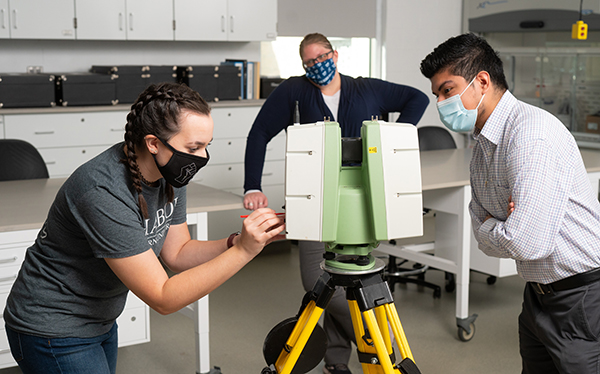Sharper Image
Donated 3D scanner gives students an edge up

From The Ichabod - Winter 2021
It’s sounds like something you would see on an episode of "Law & Order:"
A crime has been committed. The lead investigator collects data at the scene, takes it back to the lab and uses highly sophisticated equipment to dissect minute details that determine what really happened – details that ultimately end up solving the case and saving the day.
But for Washburn University students, this television-worthy, state-of-the-art technology is well within reach.
Washburn’s criminal justice and legal studies department recently received a 3D scanner donated from the Kansas Bureau of Investigation. With this high-tech equipment, students will be able to obtain real-world experience in the classroom setting, as well as training on equipment that will help them on the job or in graduate school.
The Proper Equipment
KBI has an ongoing collaborative effort with Washburn, an effort that has been further strengthened by the KBI Forensic Science Center that opened on campus in 2015. So, when it was time to upgrade KBI’s 3D scanning equipment, it was natural for the KBI’s executive officer, Robert Jacobs, mcj ’99, adjunct professor, forensic investigations, to suggest they make the donation.
“At the time, Washburn was getting ready to start a forensic investigation program in the criminal justice department. I thought it would really benefit Washburn to offer a 3D scanning class so we can teach our students to do scanning.
That way they're better prepared when they enter the field of criminal justice or law enforcement,” Jacobs said.
Originally purchased by KBI in 2011, the donated equipment – the Leica ScanStation C10 – is one that can be set up in varying locations throughout a crime scene to make a 360-degree image of the scene. The device, which originally cost more than $100,000 can capture 50,000 data points per second, making the recreation of a crime scene incredibly realistic.
“If a witness to a crime stated that he or she saw the crime happen from their bedroom window, you could use the 3D scanner to create a view out the bedroom window and potentially replicate exactly what the witness saw in a court of law,” said Jacobs. “If there was a tree in the way of the view of the crime, the 3D scan could help investigators confirm or refute witness statements.
Head of the Class
To help make the scanning class a reality, Washburn purchased a Leica BLK360 imaging laser scanner to use alongside the C10, customized laptops and the scanning software used to create the digital images of crime scenes. Melanie Worsley, jd ’07, chair and associate professor, criminal justice and legal studies, says as agencies across the country are beginning to use this kind of technology in the field, it’s important to teach these skills.
“Having the opportunity to use two different models of laser scanners will make students more versatile in their ability to conduct scans,” she said. “Learning the entire scanning process will make students more marketable in the field and will help to distinguish them from other applicants.”
Emma Morrisey, a current Washburn criminal justice major with an emphasis in forensics, is excited to learn how to use the equipment.
“It will be interesting to see how crime scenes are mapped differently with this technology,” Morrisey said. “The more hands-on experiences you have with these technologies the better.”
Morrisey also considered the future implications this type of technology could have in the courtroom, as she one day hopes to go on to receive a law degree.
“I'm thinking about how convincing it will be to show a jury a 360-degree, 3D image of a crime scene,” Morrisey said. “In criminal cases, it’s sometimes hard for people to picture what really happened. Having an almost accurate portrayal could make a big impact.”
The Big Picture
The criminal justice and legal studies department aims to offer a 3D scanning class by the fall 2021, but that’s not the only course offering that may leverage the new technology. They’re also looking for ways to incorporate it throughout the curriculum, such as in the forensic investigation lab class and an accident reconstruction course that is being developed.
“We want to make sure the students get to actually use the equipment and also learn how to process and use the data,” Worsley said.
And as this technology becomes more the norm, it will be beneficial to Washburn.
“Other universities are starting to offer 3D scanning courses, so this is not only putting students in a good position, but it’s also keeping Washburn competitive,” Jacobs said.
With the KBI partnership, students studying forensics at Washburn will continue to enter the workforce with an advantage.